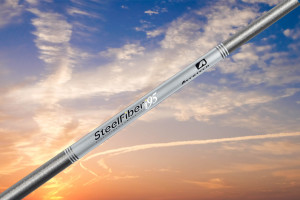 Once again, Should YOU play graphite or steel shafts in your irons? Seems like we get asked that question in every iron fitting. With 39% of our golfers saying they are looking for new irons this year, I thought I would answer that question with a couple of our fitting principles. First of all, shaft weight is one of the most important factors in fitting irons. I don’t care if you are “getting older” or not! The shaft weight has to help you optimize your performance. The lines are REALLY blurring these days between steel and graphite iron shaft weights, especially in the 95 to 110 gram weight. That weight class is were a lot of golfers either move from steel to graphite, or as juniors get stronger, move from graphite to steel. As a point of reference, traditional Dynamic Gold S300 shafts weigh roughly 130 grams, KBS Tour around 125, and Project X around 120-125. All steel shaft manufacturers have made lighter weight models, i.e. the KBS Tour 90, True Temper XP 95 to offer lighter shaft options. The reason is simple. In their world, lighter shafts means more speed which means more distance. But we have shown a wide variety of our golfers that sometimes “weight is your friend”, i.e. heavier shaft weight means more control AND more distance. That is why a fitting with a variety of shaft weights and flexes is soooooo important. Second, feel is very important and is what only you can tell us. In a fitting we always say that we will do the technical evaluation (distance, shot dispersion, launch, spin, etc.) while YOU need to tell us what looks good to your eye, sounds good to your ear, and feels good in your hands. You are the one swinging the club and if it does not feel good to you, you will not trust the club and you will lose confidence. To some golfers, graphite feels dull or dead while steel feels crisp and solid. Every golfer is different so be sure to test different shafts in your fitting and see if one feels better than the other but still gives consistent results.
Once again, Should YOU play graphite or steel shafts in your irons? Seems like we get asked that question in every iron fitting. With 39% of our golfers saying they are looking for new irons this year, I thought I would answer that question with a couple of our fitting principles. First of all, shaft weight is one of the most important factors in fitting irons. I don’t care if you are “getting older” or not! The shaft weight has to help you optimize your performance. The lines are REALLY blurring these days between steel and graphite iron shaft weights, especially in the 95 to 110 gram weight. That weight class is were a lot of golfers either move from steel to graphite, or as juniors get stronger, move from graphite to steel. As a point of reference, traditional Dynamic Gold S300 shafts weigh roughly 130 grams, KBS Tour around 125, and Project X around 120-125. All steel shaft manufacturers have made lighter weight models, i.e. the KBS Tour 90, True Temper XP 95 to offer lighter shaft options. The reason is simple. In their world, lighter shafts means more speed which means more distance. But we have shown a wide variety of our golfers that sometimes “weight is your friend”, i.e. heavier shaft weight means more control AND more distance. That is why a fitting with a variety of shaft weights and flexes is soooooo important. Second, feel is very important and is what only you can tell us. In a fitting we always say that we will do the technical evaluation (distance, shot dispersion, launch, spin, etc.) while YOU need to tell us what looks good to your eye, sounds good to your ear, and feels good in your hands. You are the one swinging the club and if it does not feel good to you, you will not trust the club and you will lose confidence. To some golfers, graphite feels dull or dead while steel feels crisp and solid. Every golfer is different so be sure to test different shafts in your fitting and see if one feels better than the other but still gives consistent results.
While there are a variety of other technical factors we use in our fittings, these two simple points can help us select the proper shaft very quickly. Getting too technical from your perspective (torque, balance point, shaft profile, etc.) will just bog you down in your decision making process. Let us help you dial in your new irons with the proper shaft that optimizes distance and shot dispersion. Then you can improve your greens in regulation, lower your scores and have more fun! You may even take a few bucks off your buddies for “greenies”!
Dan Sueltz
